Who Is Kamala Khan and Why Is She So Damn Important for Representation?
Uncovering Marvel Comics’ next Ms. Marvel in line
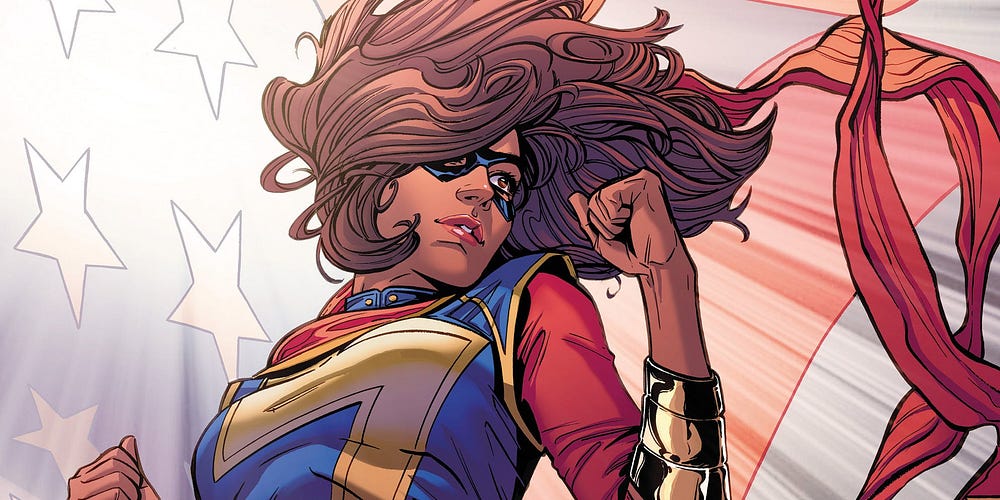
Today, I was given a comic book as a gift.
I’m not too big into the world of comics, but there was something about this comic book that peaked my interest and had me flipping through its pages until the very end in one sitting. As my left hand met the back cover and closed the book, I was only asking for more, wondering why Marvel hadn’t vested as much attention towards breaking this superhero into the public consciousness.
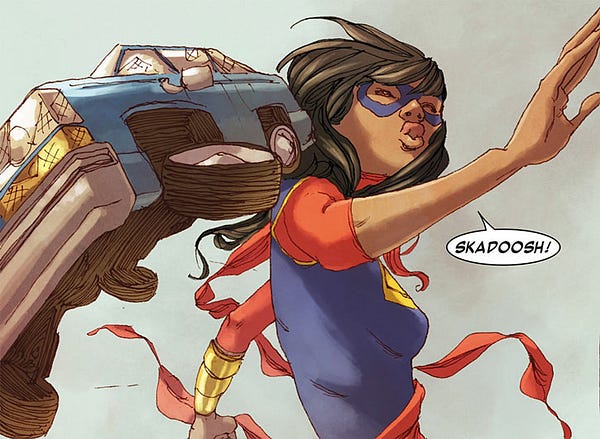
I’m talking about Kamala Khan, the Pakistani Muslim teen girl behind Marvel’s newest Ms. Marvel heroine. In this debut comic, she replaces the previous face behind the mask — Carol Danvers — in Marvel’s newest solo series showcasing her. The comic that I was given — “Ms. Marvel, Vol. 1: No Normal” — was a compilation of the first few Kamala Khan stories in paperback.
What made Kamala Khan already phenomenal before I even opened the comic book — and there’s more beneath the cover, between the lines, and within the images to attest to her greatness — was that she was Marvel’s first Muslim character with a series to her name. Then, I knew that I wasn’t holding just any old comic book; rather, I was holding the first five issues of history in the making.
First, let’s dive into Kamala’s history.
Before we can understand Kamala Khan, we need to understand who Ms. Marvel is first; Kamala was not the first fictional character to champion the title. Rather, Ms. Marvel has had its twists and turns in a complicated history of feminist representation; the issues that Kamala Khan implicitly combats both in her meta-existence, personal life, and plot line.
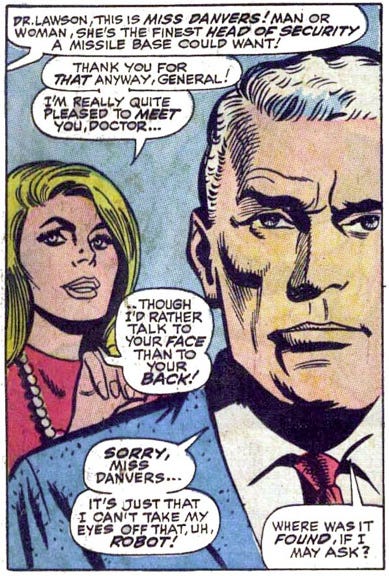
The first Ms. Marvel was Carol Danvers, who starred in Marvel publications as simply “Carol Danvers” beginning in 1968. It would take 9 years — with the beginning of 1977 — to turn Carol Danvers into her own fully-fledged superhero with her own series, which became the first iteration of Ms. Marvel.
Carol Danvers’ 1968 “debut” was hardly a debut, and few would have imagined that her initial appearance — being caught in a fatal explosion in a Captain Marvel comic — would lead to an independent Marvel series centered around her story, her ideology, and her character.
Like many superheroes, Marvel capitalized on Danvers’ initial tragedy — an explosion of otherworldly energies — to create a superhero of inhuman biology. In the wake of the Psyche-Magnetron explosion that caught both Captain Marvel and Carol Danvers in that 1968 comic, a new superhero was born from the catastrophic amalgam of Captain Marvel’s DNA with Danvers’.
Although, by 1977, the comics industry was no stranger to having female protagonists, Ms. Marvel was another step in the right direction — a small victory — that feminists championed. Alongside superheroes like Wonder Woman, Black Widow, Supergirl, and Storm, women began to see themselves in the pop culture they inhabited.
Yet, like many — if not, all — female superheroes of her time and ours, the oversight over Ms. Marvel’s creation fell victim to a patriarchal pop culture. And so, Ms. Marvel’s aesthetic was captured by a comics industry that would accept nothing other than a half-naked heroine, which the male writers and artists were more than willing to produce.
Decades later — in the November of 2013 — the character of Kamala Khan was created with intentions to replace Ms. Marvel. News of Kamala’s debut was groundbreaking to a general public and pop culture that had never before seen a Muslim superhero in the Marvel Comics universe. Shortly after in the February of 2014, the character of Kamala Khan was entered into the world.
Kamala Khan is only the second Ms. Marvel in line — a disruption of Carol Danvers’ decades-long ownership of the title — and usurps the position from Carol Danvers in Kamala’s first issues. This doesn’t mean that her character has faded out of existence; instead, Carol Danvers assumes a new role in Marvel Comics as Captain Marvel.
Why is Kamala important?
As a Pakistani woman, Kamala Khan attacks traditional representations of race, gender, and heroism within the world of comics, which has largely been undisturbed even with the introduction of characters such as Wonder Woman and Black Panther over the course of comic history. The beginning of comics was marked by the cultural hegemony of its era, leading to dominant masculinity and whitewashed heroism creating the earliest superheroes.
Even with culturally-diverse characters, these were overseen by creators, editors, and writers coming from privileged backgrounds: Wonder Woman was created by white men, Black Panther was created by white men, Carol Danvers was created by white men, and so on. Here, diversity is superficial, in the sense that characters may identify as non-white races or non-male genders; however, their value systems, ideologies, and epistemologies become grossly inaccurate under the supervision of white men who can never understand the experiences that they try to create.

The creation of Kamala Khan occurred in today’s still-problematic era for representation — with culturally-adept movie adaptations of Wonder Woman and Black Panther but terrible appropriations under Doctor Strange and Iron Fist — and under the oversight of a diverse set of creators: editor Sana Amanat, a Pakistani woman; writer G. Willow Wilson, a Muslim woman; and Adrian Alphona, an artist of color.
Today, the world of comics is still struggling with extending diversity beyond character demographics, but these three Marvel creators banded together to create more than a solution, but a culturally-immortal character that would continue to live on in comic history: Kamala Khan.
What’s Kamala’s story?
Not only is Kamala Khan a Muslim superhero, but her experiences as a Pakistani girl growing up in Jersey City, NJ reflected much of the issues that Muslims, women, and Muslim women face in America. Kamala’s stories reflect much of Sana Amanat’s upbringing, which was the crux of Kamala’s conception as Marvel Comic’s next superhero.
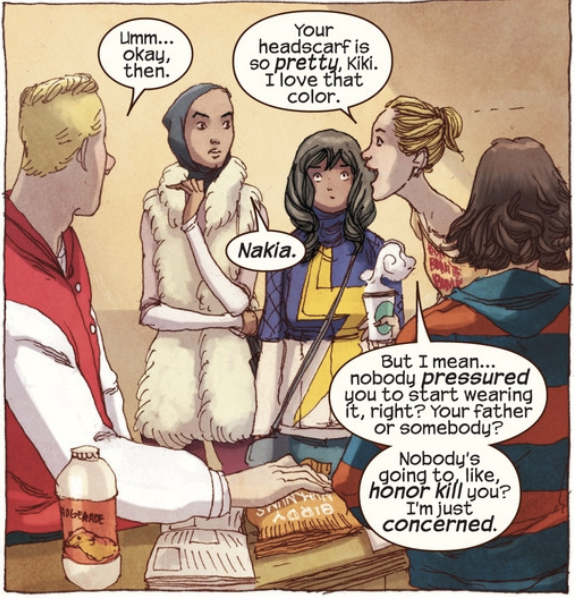
She doesn’t just battle villains — such as the Inventor, who maliciously manipulates technology — but also the issues of her time. Not only are there a variety of systemic conflicts that Kamala faces, but they also interact in ways that reflect how power really works.
Zoe Zimmerman — Kamala’s classmate — kicks off the comic with insensitive comments regarding headscarves and honor killings. She’s the epitome of micro-aggression which Kamala finds herself dealing with more so than the problems that traditional heroes face.
Jersey City, NJ is an urban region that is no stranger to the crippling forces of capitalism; Kamala Khan grew up in a neighborhood that was financially-difficult for her family, and their status as Muslims and immigrants only adds an even more difficult intersection to the class mix.
Kamala’s assumption of Carol Danvers’ roles juxtaposes the original half-naked heroine with the modern contexts of feminism and a progressive female readership, which forces her to reconcile what it means to be a female superhero; in doing so, she simultaneously challenges the beliefs of her world and ours.
A deeper look into Kamala’s home life reveals a struggle with religion that shows how difficult it is to be a “foreigner” and an “American” at the same time. Kamala is deeply-committed to her faith, but also deeply-committed towards understanding life in America and succeeding in that prospect. As she sneaks out at night to go to high school parties filled with unruly endeavors, Kamala finds herself trapped between the unstoppable forces of tradition and change.
Kamala Khan reflects a never before seen level of consciousness on Marvel Comics’ part, where systems of oppression aren’t just acknowledged or footnoted, but become intrinsic to the background, character, and conflict all at once and actively intersect within the constructions of a comic world.
So what?
Her social location in her world is complex, but her role in our world is equally as — if not, much more — difficult to reconcile. Readers will be stumped and surprised as they unveil the multiple — yet, mutually-constitutive — forces at play in Kamala’s world, but also in seeing Kamala Khan exist in their own world: a Pakistani Muslim girl taking on the role of Ms. Marvel.
Reading “Ms. Marvel, Vol 1: No Normal” today was a powerful moment that signaled for far more to come. The drafting, editing, and publishing of this article is a testament to how much Kamala Khan matters to me and readers around the world who are tired of waiting to see themselves in the comic books they peruse in convenience stores, bookstores, and libraries.
With culturally-relevant heroes such as Wonder Woman and Black Panther carving out spaces in the cinemas for a larger diversity of characters, I wouldn’t be surprised to see Kamala Khan seize the big screen in the near future. I’ll be waiting for when she does, and there’s no guarantee that I won’t lose my shit when she gets there.
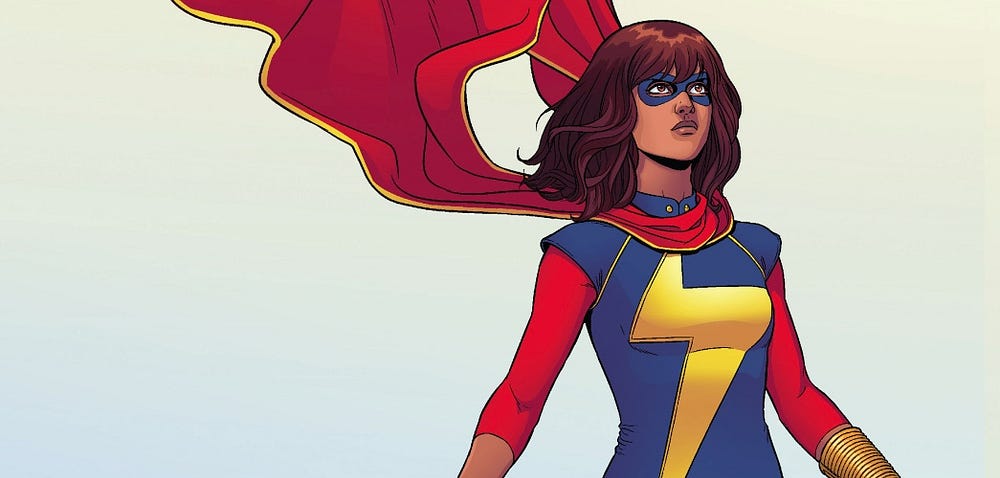
A spread from G. Willow Wilson on Marvel Comics
